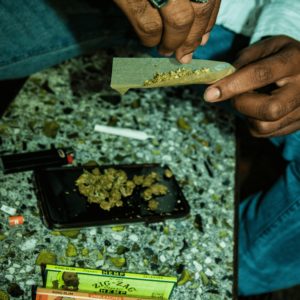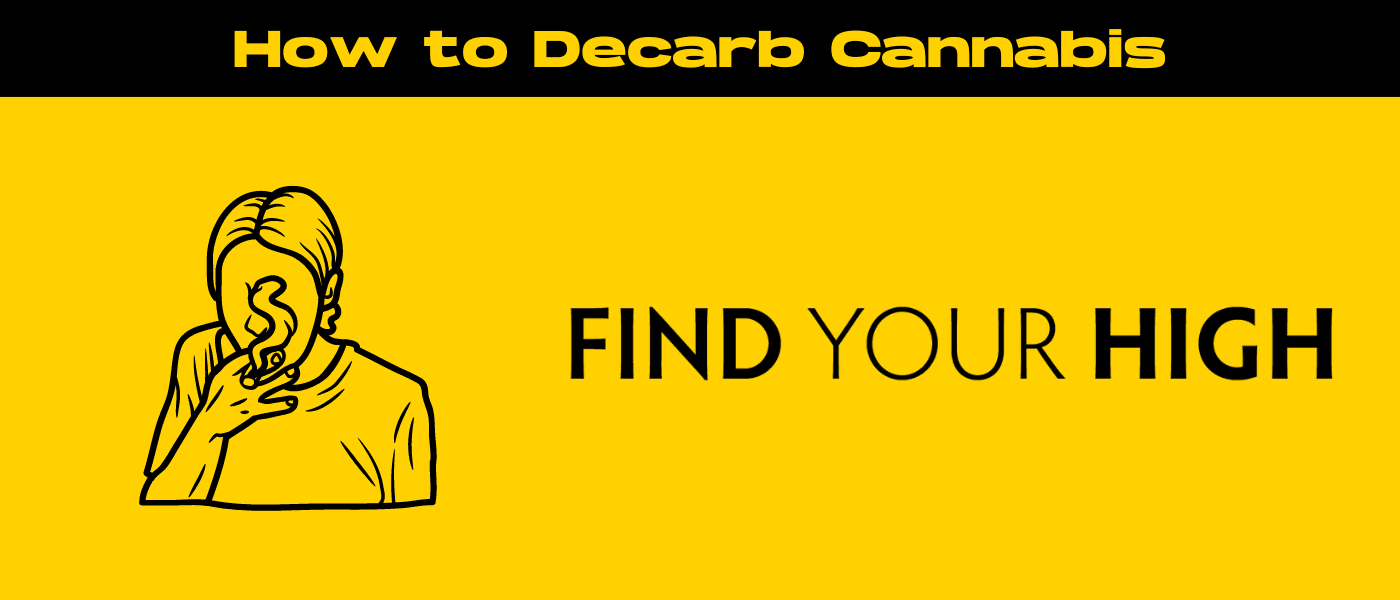When it comes to cannabis, there’s a lot to learn about how it’s processed before it reaches your hands. Whether you’re a cannabis connoisseur or a first-time user, understanding the best ways to decarboxylate cannabis is crucial for unlocking the full potential of this plant.
In this guide, we’ll explore the science behind decarboxylation, why it’s necessary for achieving the desired effects, and how you can decarb your cannabis at home. Let’s dive in!

Introduction to Decarboxylation
Before you consume cannabis, whether it’s in the form of edibles, concentrates, or even just smoking THCa flower, the process of decarboxylation plays a major role. So, what exactly is decarboxylation?
In simple terms, decarboxylation is a chemical reaction that occurs when heat is applied to cannabis, converting inactive cannabinoids (like the cannabinoid acids THC-A and CBD-A) into their active forms (THC and CBD). For most users, decarboxylation is essential to unlocking the full desired psychoactive effects and therapeutic benefits of cannabis.
While smoking and vaping naturally decarb cannabis through combustion, many methods of consumption—like edibles or tinctures—require you to decarb the cannabis first to activate the cannabinoids. Without decarboxylation, you could be consuming cannabis that won’t provide the expected effects.
The Science Behind Decarboxylation
At the molecular level, decarboxylation involves the removal of a carboxyl group from a cannabinoid molecule. In cannabis, the most well-known cannabinoids—THC and CBD—exist as their acidic forms (THC-A and CBD-A) when fresh. These acidic versions are not psychoactive or as potent in medicinal terms.
When cannabis is heated (above a certain temperature), the carboxyl group detaches, turning THC-A into THC and CBD-A into CBD. This activation process is what allows you to feel the effects you expect from cannabis.
While decarboxylation is important for both THC and CBD, the heat needed to decarb cannabis also activates terpenes, the aromatic compounds responsible for cannabis’ distinct scent and therapeutic properties.
Why Decarboxylation is Crucial for Cannabis Consumption
You may wonder why decarboxylation matters if you’re simply smoking or vaping cannabis. After all, the heat from smoking or vaping should already activate the cannabinoids, right?
Yes, but decarboxylation is especially important for edibles and concentrates. For instance, THC-A, the precursor to THC, doesn’t produce the “high” you expect unless it’s decarbed. So if you skip this step when making edibles, the cannabis won’t have the same effects as smoking it directly.
Key Points:
- THC-A vs. THC: THC-A is non-psychoactive, while THC provides the euphoric and psychoactive effects cannabis is known for.
- CBD-A vs. CBD: Similar to THC, CBD-A is non-psychoactive, and decarboxylation activates its full potential in medicinal use.
Therefore, decarboxylation is essential for making sure you get the full experience when using cannabis in non-combustible forms.
Common Methods for Decarboxylating Cannabis
While you can certainly leave decarboxylation to the professionals when purchasing pre-made cannabis products, many users prefer to decarb at home, especially when making edibles or tinctures. There are several methods to choose from, each with its pros and cons.
Oven Decarboxylation
The oven method is one of the most popular ways to decarb cannabis at home to activate the THC. It’s simple, affordable, and doesn’t require any fancy equipment. Here’s how to do it:
- Preheat your oven to 220°F (105°C).
- Break your cannabis into smaller pieces and spread them evenly on a baking sheet lined with parchment paper.
- Place the baking sheet in the oven and bake for 30-45 minutes.
- Keep an eye on the color; it should turn a light brownish-gold.
Pros:
- Easy to follow.
- Inexpensive.
Cons:
- The smell of decarbing weed can be strong and linger.
- Risk of overcooking if you don’t monitor the temperature closely.
Slow Cooker Method
If you want a low-maintenance method that involves minimal effort, the slow cooker method might be your go-to. It’s a slower process but results in a more consistent decarboxylation.
- Add cannabis to the slow cooker with a small amount of water to prevent burning.
- Set it on low heat (around 200°F) for 4-6 hours.
- Check periodically to make sure it’s not overheating.
Pros:
- Gentle heat, reducing the risk of burning.
- Minimal effort required.
Cons:
- Takes several hours to complete.
- Can be messy.
Instant Pot or Pressure Cooker Method
For those who want to speed up the process, the Instant Pot or a pressure cooker can decarb cannabis quickly and efficiently. It uses high-pressure steam to achieve decarboxylation in just under an hour.
- Place cannabis in a mason jar or heat-safe container.
- Fill the Instant Pot with water, setting the jar inside, and seal.
- Set the Instant Pot to high pressure for 40 minutes.
Pros:
- Fast and effective.
- Easy to clean up.
Cons:
- The risk of overheating or uneven decarb if not properly monitored.

How to Decarboxylate Cannabis for Edibles
When making cannabis edibles, decarboxylation is a must. Without it, the cannabinoids won’t be activated and you won’t feel the effects.
Here’s how to properly decarb cannabis for edibles:
- Preheat your oven to 220°F (105°C).
- Spread your cannabis out evenly on a baking sheet lined with parchment paper.
- Bake for 30-40 minutes, shaking the tray halfway through for even heating.
- Once decarbed, the cannabis is ready to be infused into butter, oil, or any edible of your choice.
Pro tip: Grind your cannabis coarsely before decarbing to ensure even heat distribution. Also, remember that the decarbed cannabis can be mixed into your recipe without further heating!
Decarboxylation for Concentrates and Extracts
If you’re working with concentrates like wax, shatter, or hash oil, decarboxylation is still essential to activate the cannabinoids. Concentrates usually contain higher concentrations of THC or CBD, so properly decarbing them ensures you get the full potency.
For concentrates, a low-heat method is usually preferred. Gently heat them in an oven-safe container or a double boiler for 30-60 minutes, making sure not to exceed 240°F.
Pro Tip: If you’re using a concentrate for making edibles or oils, you may need less concentrate than you think, given the high potency.
Signs of Proper Decarboxylation
How do you know when your cannabis is properly decarbed? It’s all about the color, texture, and aroma.
- Color: Your cannabis should turn from a bright green to a golden brown.
- Texture: It will be dry and crumbly, not sticky or moist.
- Aroma: The smell will shift from fresh plant-like to a more pungent, earthy aroma, which signifies that the decarb process is complete.
Avoiding Common Decarboxylation Mistakes
Even experienced cannabis users can make mistakes while decarboxylating. Here are some of the most common pitfalls and how to avoid them:
- Overheating: Too much heat can destroy valuable cannabinoids. Stick to temperatures between 220°F and 240°F.
- Underheating: Not heating your cannabis long enough means it won’t be activated properly. Keep an eye on the time.
- Uneven Heat: Make sure your cannabis is spread evenly to ensure consistent decarb.

Temperature Control: How Much Heat is Too Much?
Temperature control is one of the most important aspects of decarboxylation. Too much heat can burn away precious cannabinoids and terpenes, while too little heat will leave you with non-psychoactive cannabis.
- Ideal Temperature: 220°F to 240°F (105°C to 115°C) is the sweet spot.
- High-Temperature Risks: Anything above 250°F can cause cannabinoids like THC to break down.
Using a thermometer is a good way to ensure you’re staying within the safe range.
Using Decarboxylated Cannabis for Making Oils and Tinctures
Decarboxylated cannabis is ideal for infusing oils and tinctures. By activating the cannabinoids, you increase their potency and make them more bioavailable for your body.
To make cannabis oil or tincture, simply mix your decarbed cannabis with a carrier oil (like MCT oil or coconut oil) or alcohol (for tinctures). Gently heat the mixture in a double boiler for 3-4 hours. The result is a potent infusion you can use for various recipes or direct consumption.
The Role of Decarboxylation in Medical Cannabis
For medical cannabis users, consistency is key. Decarboxylation ensures that the cannabis you use has predictable effects, especially if you are dosing for specific therapeutic purposes. Proper decarb helps maintain the potency and effectiveness of your medicine.
For patients relying on CBD for pain, anxiety, or other health issues, decarboxylation can significantly increase the therapeutic effects, as CBD-A is far less effective before it is activated.
Conclusion: Why Mastering Decarboxylation is Essential for Cannabis Enthusiasts
Decarboxylation might seem like a minor step, but it plays a huge role in ensuring that your cannabis works the way you expect it to. Whether you’re making edibles, tinctures, or using concentrates, understanding how to decarb your cannabis properly is a game-changer for any cannabis enthusiast.
By following the right methods and ensuring proper temperature control, you’ll unlock the full potential of your cannabis, resulting in more potent and effective experiences. So go ahead, experiment with decarboxylation, and elevate your cannabis game today!

Frequently Asked Questions
1. What is the best method to decarboxylate?
The best method to decarboxylate cannabis depends on your preferences and resources. The oven method is the most commonly used and effective for most people. It’s simple, accessible, and provides reliable results. For a gentler, more hands-off approach, the slow cooker method works well, though it takes more time. If you’re looking for speed, using an Instant Pot or pressure cooker can decarb cannabis quickly and efficiently while retaining potency. Each method has its pros and cons, so choose based on the time you have and your equipment.
2. Is decarboxylation necessary for edibles?
Yes, the decarboxylation process is necessary for edibles if you want to experience the full effects of THC and CBD. Raw cannabis in its natural state contains cannabis acids, THC-A and CBD-A, which are not psychoactive. By heating cannabis (through decarboxylation), these compounds are converted into THC and CBD, which are the active forms responsible for the effects you feel. Without decarbing your cannabis, your edibles won’t have the desired potency.
3. What is the point of decarbing?
The point of decarbing cannabis is to activate the cannabinoids, specifically THC and CBD, which are responsible for the plant’s psychoactive and medicinal effects. In its raw form, cannabis contains THC-A and CBD-A, which are not effective when consumed. Heat transforms these acidic cannabinoids into their active counterparts, making them bioavailable to the body. Whether for edibles, tinctures, or concentrates, decarboxylation ensures you get the full therapeutic and recreational benefits.
4. How to decarboxylate herbs?
Decarboxylating herbs, such as cannabis flower, follows a similar process for most plant materials. If you’re decarbing cannabis buds specifically, the most common method is to preheat your oven to 220°F-240°F (105°C-115°C). Spread the herb evenly on a baking sheet lined with parchment paper, and bake for 30-45 minutes, shaking the sheet halfway through for even heat distribution. If you’re using a slow cooker or Instant Pot, the same principle applies: apply low, consistent heat over a period of time. Just make sure you monitor the temperature closely to avoid burning or degrading the cannabinoids.





